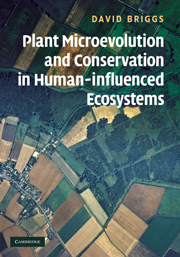Book contents
- Frontmatter
- Contents
- Preface
- Acknowledgements
- List of abbreviations
- 1 Introduction
- 2 Studying change
- 3 Key concepts in plant evolution
- 4 The origin and extent of human-influenced ecosystems
- 5 Consequences of human influences on the biosphere
- 6 Categories
- 7 Investigating microevolution in plants in anthropogenic ecosystems
- 8 Plant microevolution in managed grassland ecosystems
- 9 Harvesting crops: arable and forestry
- 10 Pollution and microevolutionary change
- 11 Introduced plants
- 12 Endangered species: investigating the extinction process at the population level
- 13 Hybridisation and speciation in anthropogenically influenced ecosystems
- 14 Ex situ conservation
- 15 In situ conservation: within and outside reserves
- 16 Creative conservation through restoration and reintroduction
- 17 Reserves in the landscape
- 18 Climate change
- 19 Microevolution and climate change
- 20 The implications of climate change for the theory and practice of conservation
- 21 Overview
- References
- Index
15 - In situ conservation: within and outside reserves
Published online by Cambridge University Press: 05 June 2012
- Frontmatter
- Contents
- Preface
- Acknowledgements
- List of abbreviations
- 1 Introduction
- 2 Studying change
- 3 Key concepts in plant evolution
- 4 The origin and extent of human-influenced ecosystems
- 5 Consequences of human influences on the biosphere
- 6 Categories
- 7 Investigating microevolution in plants in anthropogenic ecosystems
- 8 Plant microevolution in managed grassland ecosystems
- 9 Harvesting crops: arable and forestry
- 10 Pollution and microevolutionary change
- 11 Introduced plants
- 12 Endangered species: investigating the extinction process at the population level
- 13 Hybridisation and speciation in anthropogenically influenced ecosystems
- 14 Ex situ conservation
- 15 In situ conservation: within and outside reserves
- 16 Creative conservation through restoration and reintroduction
- 17 Reserves in the landscape
- 18 Climate change
- 19 Microevolution and climate change
- 20 The implications of climate change for the theory and practice of conservation
- 21 Overview
- References
- Index
Summary
A call for parks to preserve forests
Wallace, the co-founder, with Darwin, of the theory of evolution by natural selection, understood the value – and the vulnerability – of the natural world. Writing in 1910, he made an impassioned plea (quoted in Berry, 2002, 147):
It is really deplorable that in so many of our tropical dependencies no attempt has been made to preserve for posterity any adequate portions of the native vegetation, especially of the virgin forests…Surely before it is too late…a suitable provision shall be made of forest or mountain ‘reserves’, not for the purpose of forestry and timber cutting alone, but in order to preserve adequate and even abundant examples of those most glorious and entrancing features of our earth, its native forests, woods, mountain slopes, and alpine pastures.
The concept of nature reserves has a long history. As we shall see, important advances were made in the nineteenth century, with the development of national parks in North America. Currently, it has been estimated that c. 7.9% of the Earth's land surface and c. 0.5% sea area are protected in reserves of various kinds (Balmford et al., 2002, 952). Ten different types of parks are listed by Given (1994, 96; Table 15.1), ranging over closed reserves, national parks, extractive reserves etc. The establishment of reserves for nature conservation has been one of the most important and ‘enduring strategies for the conservation of global diversity’ (Hopper, 1996, 253).
- Type
- Chapter
- Information
- Publisher: Cambridge University PressPrint publication year: 2009

